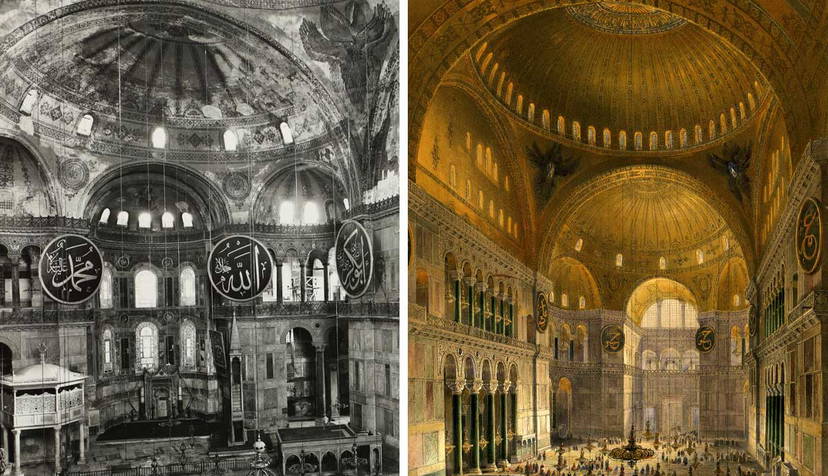Hagia Sophia: Exploring The Megastructure's Resilience

Table of Contents
The Ingenious Design of Byzantine Architecture
The Hagia Sophia's resilience is deeply rooted in the innovative architectural principles employed by its Byzantine builders. Understanding these principles is key to appreciating the megastructure's lasting impact. Key elements of Byzantine architectural innovation include:
-
Pendentives: The masterful use of pendentives—spherical triangles—was crucial in supporting the massive dome. This architectural innovation allowed the dome to rest on a square base, a feat of engineering brilliance unmatched for its time. The pendentives effectively distributed the immense weight of the dome, preventing stress concentration on any single point.
-
Buttresses: Strategically placed buttresses reinforced the walls, further distributing the structural load. These external supports acted as counterweights, countering the outward pressure exerted by the dome and the internal forces within the building. Their presence significantly enhanced the building's resistance to seismic activity.
-
Load-Bearing Walls and Arches: The use of load-bearing walls and arches formed a robust skeletal system, distributing weight efficiently throughout the structure. This interconnected network of load-bearing elements created a strong and stable framework capable of withstanding considerable stress. The interplay between these elements is a prime example of Byzantine architectural mastery.
-
Seismic Considerations (Implicit): While not explicitly documented as a design goal, the Hagia Sophia's design implicitly incorporated elements that contributed to its earthquake resistance. The flexible nature of the dome, the distribution of weight through the buttresses and arches, and the use of durable materials all played a role in the building's ability to withstand seismic activity throughout its history.
Materials and Construction Techniques
The Hagia Sophia's longevity is not solely attributable to its design; the quality of materials and construction techniques employed played a vital role.
-
Building Materials: The builders utilized high-quality brick, mortar, and marble extensively. The bricks, renowned for their strength and durability, were meticulously laid, contributing to the overall structural integrity. The mortar used was of exceptional quality, ensuring strong bonding between the bricks and other elements. The choice of marble, not just for aesthetic reasons but also for its durability, further enhanced the building's resistance to the elements.
-
Construction Methods: The sophisticated construction techniques of the time were crucial. The precise craftsmanship and attention to detail evident in the brickwork and the joining of various components ensured the stability and longevity of the structure. Innovative methods of arch and dome construction, honed over generations of Byzantine builders, ensured that the weight was distributed optimally.
-
Durability and Longevity of Materials: Research on the materials used in the Hagia Sophia has revealed their exceptional durability. The composition of the mortar, for instance, has been found to possess unique properties that enhance its long-term strength and resistance to degradation. The enduring quality of the materials used speaks volumes about the foresight and expertise of the Byzantine builders.
Withstanding the Test of Time: Earthquakes and Repairs
Istanbul's location within a seismically active zone means the Hagia Sophia has experienced numerous earthquakes throughout its history. Despite this, the building has remarkably survived, thanks to a combination of its inherent resilience and timely repairs.
-
Historical Seismic Activity and Damage: Numerous historical records detail the impact of earthquakes on the Hagia Sophia, with some causing significant damage, including cracks in the dome and walls. These events, however, did not lead to the structure's collapse, a testament to its inherent structural strength.
-
Repair and Restoration Work: Following earthquake damage, extensive repair and restoration work was undertaken throughout the centuries. These efforts, often involving complex structural interventions, ensured the continued integrity of the building. The techniques used in these repairs were often innovative for their time, reflecting the ongoing dedication to preserving this iconic structure.
-
Modern Structural Assessments and Reinforcement: In modern times, advanced structural assessments and monitoring techniques have been employed to evaluate the building's condition and ensure its continued safety. Where necessary, carefully planned reinforcement measures have been implemented to enhance the Hagia Sophia's ability to withstand future seismic events. These interventions are done with meticulous care to preserve the historical integrity of the building.
Modern Preservation Efforts
Preserving the Hagia Sophia for future generations is a continuous process involving cutting-edge technologies and strategies.
-
Structural Monitoring: Sophisticated monitoring systems are used to constantly track the building's structural integrity, allowing for early detection of any potential problems. This proactive approach ensures that any issues can be addressed swiftly and effectively.
-
Ongoing Restoration Projects: Regular restoration projects, employing modern conservation techniques, are undertaken to maintain the Hagia Sophia’s structural and aesthetic integrity. These projects involve careful cleaning, repair, and consolidation of materials while adhering to the highest conservation standards.
-
Preservation Challenges and Public Access: Balancing preservation with public access presents unique challenges. The immense popularity of the Hagia Sophia necessitates managing visitor flow and environmental impacts while ensuring the building’s long-term protection. Sustainable preservation strategies are crucial in this context.
-
Sustainable Preservation: Modern preservation efforts increasingly focus on sustainable practices, ensuring that conservation measures have minimal environmental impact. This includes using environmentally friendly materials and techniques and minimizing the building's carbon footprint.
Conclusion
The Hagia Sophia's continued existence is a remarkable testament to the brilliance of Byzantine engineering and the ongoing dedication to preserving this incredible landmark. Its resilience, shaped by its ingenious design, robust construction, and continuous maintenance, offers invaluable lessons in architectural innovation and heritage conservation. The Hagia Sophia's story is a powerful reminder of the importance of preserving our architectural heritage for future generations. Explore the enduring legacy of the Hagia Sophia and discover the secrets behind its architectural resilience. Learn more about this incredible megastructure and the ongoing efforts to preserve its magnificence for future generations. Dive deeper into the wonders of Byzantine architecture and the enduring strength of the Hagia Sophia!

Featured Posts
-
 Thunder Over Louisville Fireworks Canceled Ohio River Flooding
Apr 29, 2025
Thunder Over Louisville Fireworks Canceled Ohio River Flooding
Apr 29, 2025 -
 Kentucky Facing Storm Damage Assessment Backlog Heres Why
Apr 29, 2025
Kentucky Facing Storm Damage Assessment Backlog Heres Why
Apr 29, 2025 -
 Understanding Adhd Avoiding Tik Tok Fueled Misinformation
Apr 29, 2025
Understanding Adhd Avoiding Tik Tok Fueled Misinformation
Apr 29, 2025 -
 Court Awards Custody Of Child To Ayesha Howard In Case Against Anthony Edwards
Apr 29, 2025
Court Awards Custody Of Child To Ayesha Howard In Case Against Anthony Edwards
Apr 29, 2025 -
 Nationwide Sanctuary City List Trumps Executive Order
Apr 29, 2025
Nationwide Sanctuary City List Trumps Executive Order
Apr 29, 2025
Latest Posts
-
 Celtics Clinch Division A Convincing Win Over Opponent Name
May 12, 2025
Celtics Clinch Division A Convincing Win Over Opponent Name
May 12, 2025 -
 Dominant Celtics Clinch Division Title With Impressive Victory
May 12, 2025
Dominant Celtics Clinch Division Title With Impressive Victory
May 12, 2025 -
 Celtics Magic Division Title Clinched With Dominant Performance
May 12, 2025
Celtics Magic Division Title Clinched With Dominant Performance
May 12, 2025 -
 Boston Celtics Clinch Division Blowout Victory
May 12, 2025
Boston Celtics Clinch Division Blowout Victory
May 12, 2025 -
 Two Unlikely Celtics Players Achieve 40 Point Games A Historic Night
May 12, 2025
Two Unlikely Celtics Players Achieve 40 Point Games A Historic Night
May 12, 2025
